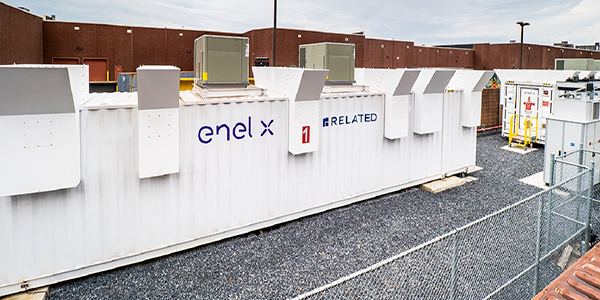MISO’s much debated first rule set for storage resources functioning as transmission assets passed muster with FERC on Monday, though Commissioner James Danly opposed the plan (ER20-588).
The commission approved the proposal, effective immediately, subject to MISO providing more explanation on storage-as-transmission resources’ impact on the interconnection queue, special commercial pricing nodes for the resources and instances when storage wouldn’t be used to solve transmission reliability issues.
Danly dissented, saying the plan “impermissibly blur[s] the line between generation and transmission.”
The rules limit storage-as-transmission assets to transmission-only functions operated by MISO-defined transmission owners. Such assets will be called storage-as-transmission-only assets (SATOAs) and will be barred from simultaneous participation in the RTO’s energy markets, with SATOA owners responsible for the resources’ states of charge. SATOAs would be selected using MISO’s annual Transmission Expansion Plan (MTEP).
FERC accepted and suspended the plan in March, suggesting that some aspects could be unjust and unreasonable. MISO defended the plan in front of FERC in May at a technical conference on the proposal. The grid operator said the plan is intended to be an interim measure while it designs a more comprehensive approach to allow storage resources to simultaneously participate in the energy markets while providing transmission solutions. (See MISO Plugs SATOA Plan at FERC Conference.)
The RTO has repeatedly argued that the short-term plan will avoid introducing complexities around cost recovery, particularly related to how non-TOs would be compensated for providing transmission services. The grid operator has promised to hold stakeholder discussions beginning in 2021 on dual-mode participation of storage in both markets and on the transmission system.
Many in the MISO stakeholder community have said the rules would give incumbent TOs an effective monopoly on storage assets functioning as transmission, harming competition. (See MISO SATOA Proposal Faces Opposition.) DTE Energy has been especially outspoken against the plan, maintaining it will create unduly discriminatory preference for TOs over generation owners with comparable projects.
FERC was not swayed by those claims.
“We are not persuaded by protesters’ arguments that MISO’s proposal is unduly discriminatory toward non-transmission owners seeking to develop storage for transmission uses. As protesters assert, a SATOA is most likely to qualify as a baseline reliability project or other project, and Order No. 1000 allows transmission owners to maintain a right of first refusal for such categories of transmission projects,” the commission said.
FERC said that because SATOA would be bound to the same requirements as other transmission projects, the protesters’ concerns seemed to be about the RTO’s existing Tariff rules, which were not under scrutiny.
The commission also determined that MISO’s rules for SATOA evaluation under the annual MTEP process and its proposal to develop unique operating guides for each asset were fair.
“MISO’s proposed evaluation criteria will result in MISO choosing SATOAs that are properly characterized as transmission assets eligible for cost recovery in transmission rates,” FERC said. “The proposal ensures that SATOAs will be subject to adequate scrutiny in order to ensure that the SATOA is the preferred solution to an identified transmission need.”
Some protesters argued that MISO should treat SATOAs the same as non-transmission alternatives (NTAs), which must first clear the RTO’s approximately three-year generation interconnection queue before being placed in operation. SATOAs, meanwhile, would only have to clear the RTO’s annual MTEP studies. But the commission noted that the RTO is only required to consider proposed NTAs as alternatives to transmission solutions, while SATOAs will be considered as transmission solutions themselves. “MISO’s SATOA proposal does not change MISO’s existing process to consider transmission and NTAs on a comparable basis,” it said.
Some Revisions Needed
FERC said MISO’s plan sets reasonable limitations on SATOAs’ activity; however, it ordered the RTO to further detail the special commercial pricing nodes it will create for energy injection or withdrawals. The RTO needs to make plain that no other energy trading activities will be allowed at the new nodes, FERC said.
The commission also said MISO, for the most part, built in adequate protections so that SATOAs don’t affect generators seeking to interconnect. But it said the plan lacked detail on how the RTO will evaluate the impact of a SATOA on the interconnection queue and ordered the RTO to document the process in a new filing.
Finally, FERC directed MISO to clarify that it doesn’t intend to use SATOAs to correct routine reliability transmission issues that could instead be solved by a market solution.
Danly: Discrimination Claims Inevitable
Commissioner Danly said MISO’s proposal improperly conflated generation and transmission.
“No matter how our order characterizes the function of energy storage facilities, the service contemplated by [MISO’s] filing is accomplished through the discharge of energy from storage units into the MISO transmission system. That, in my view, is a generation function, not a transmission function,” he wrote in dissent.
Danly said the order flies in the face of FERC’s precedent of unbundling transmission services provided by generation facilities from transmission rates. He said it’s only natural that “similarly situated,” non-transmission-owning parties want a better explanation as to why they can’t own SATOAs.
“I am concerned that, once the door is opened, it can swing in only one direction, and we soon will be faced with proposals seeking to widen the opening ever further,” he said. “The further we expand the definition of transmission by including facilities that inject energy into the system, the more difficult it will be to prevent yet further expansion. And the commission will find it challenging to justify its actions in the face of the discrimination claims that inevitably will be raised by generators seeking the same full cost-of-service treatment afforded to transmission assets.”
Danly said generation assets, like storage, should be limited to providing ancillary services to preserve the bright line between transmission and generation. He said FERC should reverse its 2010 decision that allowed storage developer Western Grid to classify its resources as transmission for cost-based recovery in CAISO.




